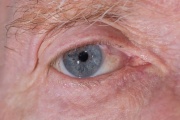Contents |
Pinguecula
A pinguecula (pin-gwek-u-la) is a benign, yellowish-whitish nodule or small plaque that develops on the conjunctiva, the clear skin that covers the insides of the eyelids and the whites of the eyes, as a result of ultraviolet light exposure.
This photo shows a pinguecula on the white of the eye in the nasal cornea. The pinguecula is yellowish in color and raised slightly, which can interfere with the smoothness of the tears on the surface.
Most people know that ultraviolet (UV) light is harmful to the skin in the form of increased wrinkling, premature aging, sunburn and several forms of skin cancer. However, UV is also harmful to the eyes. Most of the damage caused by UV light occurs gradually and is irreversible.
A pinguecula develops gradually, caused by the degeneration of the connective tissues in the conjunctivia. The damaged fibres are replaced by thicker, yellowish ones, or in some cases, calcified deposits form. Usually, a pinguecula grows on the nasal side of the eye and are found in both eyes. The pinguecula does not effect vision, but rarely, it can progress to become a pterygium, a wedge-shaped growth that can extend over the edge of the cornea.
Pingueculas are common in adults and their frequency increases with age. Overexposure to UV light as well as wind, dust and toxic vapours contribute to these small ocular growths. Smoky environments and dryness can worsen and enlarge pingueculas.
A larger lesion, called a pterygium, is thought to develop in some cases from a pinguecula. Both growths or plaques are thought to be caused by UV light, wind and dry conditions.
Symptoms
Usually, there are no outward symptoms of a pinguecula, except cosmetic concerns. In some cases, the conjunctivia can become red and irritated, which can worsen any dry eye symptoms and irritation, which results in increased awareness and inflammation. The presence of symptoms such as redness, grittiness, burning and stinging can be significant to call attention to dry eye syndrome and inflammation of the eyelids and conjunctivia.
Treatment
A pinguecula usually does not require treatment, although its presence can signal an eyecare practitioner to diagnose and assess it, along with possible eyelid and conjunctiva issues. The slit lamp microscope, an optical instrument that allows a greatly magnified view of the entire front of the eye is invaluable in evaluating pingueculas, and the tear film to determine if underlying dry eyes could be a factor.
As pingueculas are generally benign, they don’t usually require treatment, but if they cause irritation and inflammation, artificial tears for lubrication and moisture may help alleviate any redness or swelling. Cold compresses twice a day are also helpful.
To prevent progression, protection from UV light with wide-brimmed hats and UV-blocking sunglasses, used consistently, will help prevent worsening of the situation and growth of the pinguecula.



